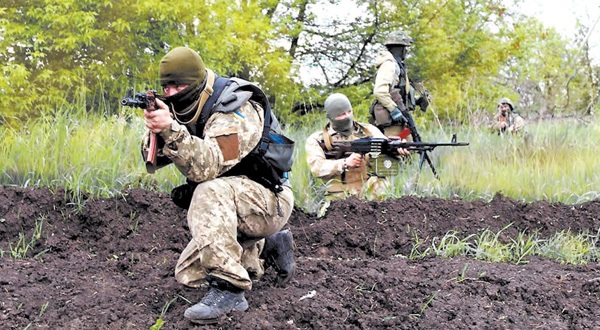
Hardly anyone sees their faces, knows their surnames or even their names. These soldiers have to act on enemy territory, more often than not in the rear. We are referring to reconnaissance men.
Even today, despite the relative armistice in ATO area, they are performing duty at the front line, gleaning information about the enemy. Reconnaissance men are the “eyes and ears” of their commanders and headquarters.
Any commander’s decision is based on intelligence data. That is why requirements to the knowledge and skills of these specialists are strict. Their combat preparation never stops, even for a minute. However, as reconnaissance men say, this does not mean that they are constantly fully equipped and performing some sort of combat training tasks. Considering that the most effective weapon of a reconnaissance man is his intellect, his ability to analyze a situation and to make a proper decision, an important element of training is the continuous improvement of their professional skills.
Professional language
When performing tasks, reconnaissance men communicate mainly with the help of gestures.
We also use some of them in our day-to-day lives. For example, a forefinger raised to the lips means “Be silent!, while a forefinger pointed at oneself means “I”.
But there are specific gestures. “Down!” – raise an arm bent at the elbow to one’s chin and quickly bring it down palm facing downwards. “Attention!” – raise one’s hand to the height of one’s head. “Front and center!” – raise a hand above one’s head, make circling motions and vigorously bring it down. In order to move forward, backward, sideward it is necessary to raise one’s hand to the height of one’s head and bring it down to shoulder height, pointing in the desired direction. “See enemy!” – put out one’s hand sideward horizontally and hold it. “See, hear (answer)” – raise hand up to the height of one’s head and bring it down. “Approach the enemy noiselessly” – point the direction with one’s left hand and make several zigzagged movements with the palm of one’s right hand.
Overall, there is no defined system of gestures in military intelligence. Each reconnaissance group has its own code but with one common element: they must be easy to understand and to perform.
A reconnaissance man is expected to execute parachute jumps, to know the drill of being air dropped down a rope from a hovering helicopter. He must also be proficient in map reading, quick and precise in fixing essential targets, able to determine any adversary armaments by appearances, know its characteristics, excel at camouflage techniques and methods of noiseless movement through terrain, swim well, accomplish long-distance marches, be a good shot, excel at hand-to-hand fighting, know military terminology in the language of the adversary…
– And these are only the basic skills and set of experiences. It is impossible to enumerate everything that is expected from a reconnaissance man in enemy deep rear. In practice, the above-mentioned skills are divided between all the warriors of a sabotage-reconnaissance group but, theoretically, every serviceman must be able to do it, regardless of who is he according to his staff specialty: demolition man, sniper and so on, – one of the reconnaissance men of 24th separate mechanized brigade says.
And what if we dig deeper? For example, the requirements to mine-and-undermining training note: skillfully apply explosives substances and demolition means, staff mines and charges. This means that scouts must know the characteristics of explosives and demolition means, fire and electrical methods of demolition, know how to prepare charges and proper calculations for blowing up soil, wood, brick, stone, concrete, iron concrete, metal.
To put it in a nutshell, a scout must know how to and be capable of doing a lot of things, but above all – how to perform any task and stay alive at the same time. The more each every warrior knows and the more every one of them is able to do, the higher the chances are for the reconnaissance group to complete the assigned task.
ATO experience brought a lot of nuances to the training of reconnaissance men. The whole system of effective usage and work of intelligence was organized in a new fashion, involving all possible means. These include radio electronic, air and other types of reconnaissance, not only groups of combat reconnaissance men. At the same time, in each task the human factor remains on the first place.
– As experience confirms, the basic tactical unit of military intelligence remains a group of 6 – 8 warriors. While performing tasks on enemy territory a group must always act noiselessly and invisibly. If the group engages in battle, even without loss of life, the task is considered to be a failure, - my interlocutor’s colleague joins us in the conversation.
However, there are different situation. For this reason, reconnaissance men are trained to engage in combat applying the “in pairs” method of providing cover. This is a Ukrainian know-how. Soldiers use this maneuver to render fire cover to their partner when he needs to reload. The key thing is to keep the adversary on the edge, and to prevent him from launching a counterattack. In other words, when a group sees an enemy – it quickly repels the attack and pulls out, in order to save strength and assets.
Roman VUS